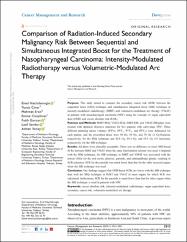Comparison of radiation-induced secondary malignancy risk between sequential and simultaneous integrated boost for the treatment of nasopharyngeal carcinoma: intensity-modulated radiotherapy versus volumetric-modulated arc therapy

View/
Access
info:eu-repo/semantics/openAccessDate
2020Author
Hacıislamoğlu, EmelÇınar, Yunus
Eren, Mehmet
Canyılmaz, Emine
Gürcan, Fatih
Serdar, Lasif
Yöney, Adnan
Metadata
Show full item recordCitation
Haciislamoglu, E., Cinar, Y., Eren, M., Canyilmaz, E., Gurcan, F., Serdar, L., & Yoney, A. (2020). Comparison of Radiation-Induced Secondary Malignancy Risk Between Sequential and Simultaneous Integrated Boost for the Treatment of Nasopharyngeal Carcinoma: Intensity-Modulated Radiotherapy versus Volumetric-Modulated Arc Therapy. Cancer management and research, 12, 2513–2521. https://doi.org/10.2147/CMAR.S244901Abstract
Purpose: This study aimed to compare the secondary cancer risk (SCR) between the sequential boost (SEQ) technique and simultaneous integrated boost (SIB) technique in intensity-modulated radiotherapy (IMRT) and volumetric-modulated arc therapy (VMAT) in patients with nasopharyngeal carcinoma (NPC) using the concepts of organ equivalent dose (OED) and excess absolute risk (EAR). Patients and Methods: IMRT-SEQ, VMAT-SEQ, IMRT-SIB, and VMAT-SIB plans were created with identical objective functions for five patients with early-stage NPC. Three different planning tumor volumes (PTVs; PTV1, PTV2, and PTV3) were delineated for each patient, and the prescribed doses were 50 Gy, 60 Gy, and 70 Gy (2 Gy/fraction), respectively, for the SEQ technique and 52.8 Gy, 59.4 Gy, and 69.3 Gy (33 fractions), respectively, for the SIB technique. Results: All plans were clinically acceptable. There was no difference in most OED-based SCRs between IMRT and VMAT when the same fractionation scheme was used. Compared with the SEQ technique, the SIB technique in IMRT and VMAT was associated with the lowest OEDs for the oral cavity, pharynx, parotids, and submandibular glands, resulting in SCR reduction. SCR for the parotids was much lower than that for the other assessed organs when the SIB technique was used. Conclusion: Our findings suggest that OED-based SCRs are lower with the SIB technique than with the SEQ technique in IMRT and VMAT in most organs for which SCR was calculated; furthermore, SCR for the parotids is much lower than that for other organs when the SIB technique is used in patients with NPC.

















